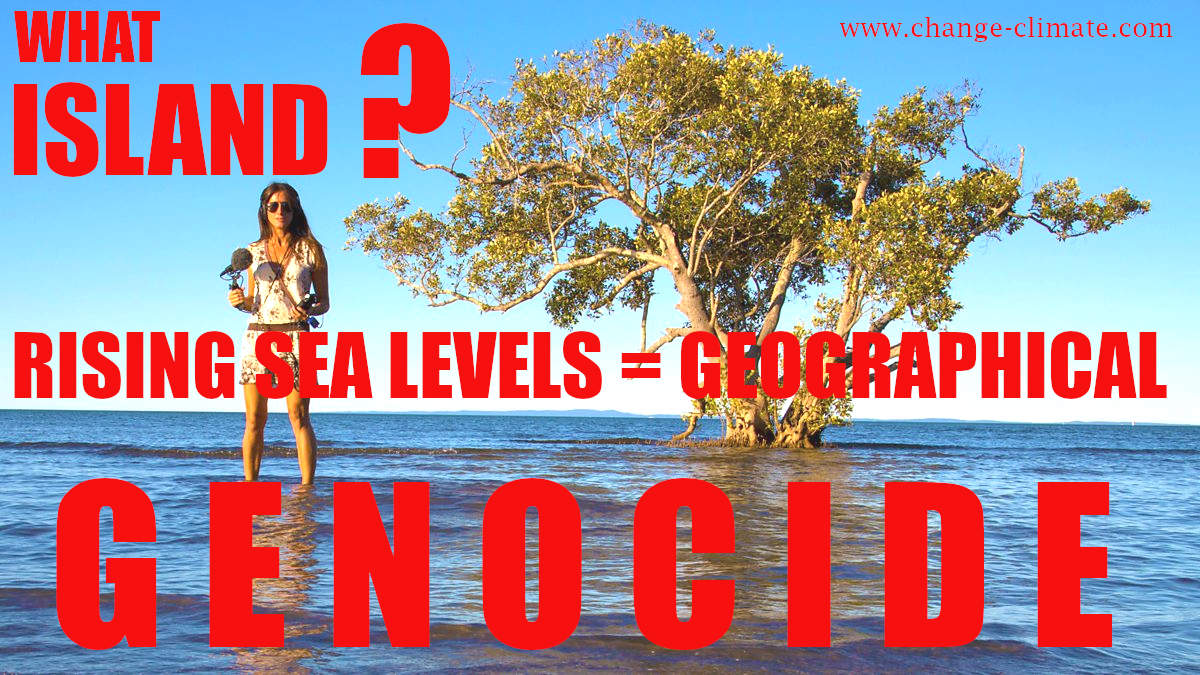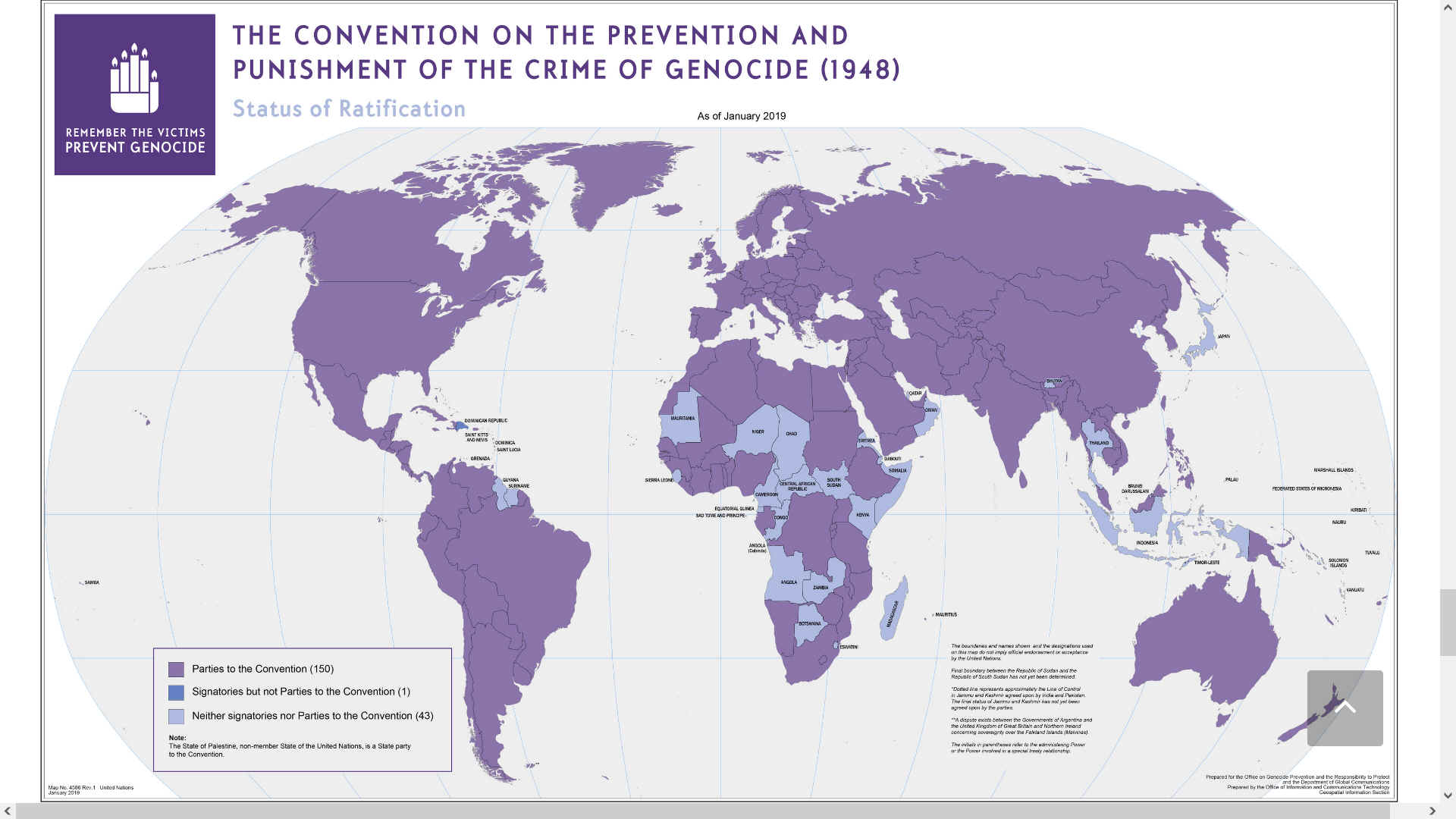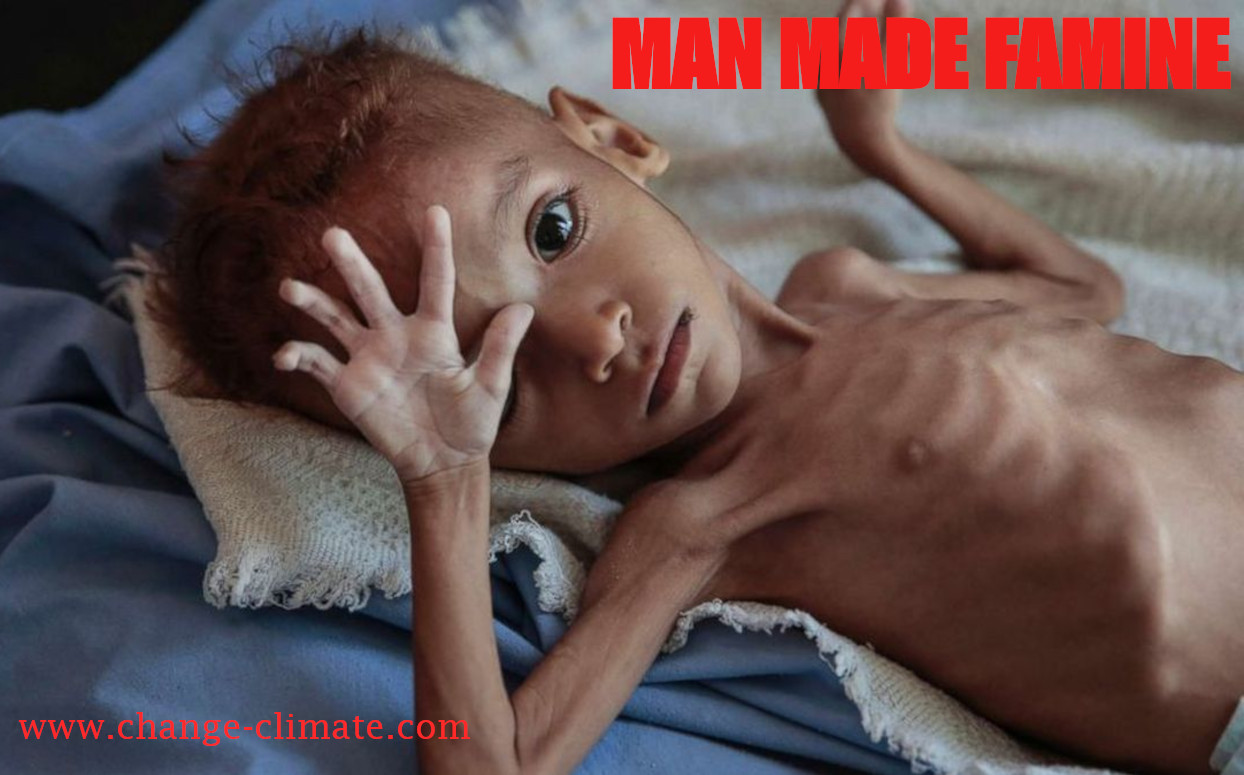
EXTREME
ETHNIC & POLITICAL CLEANSING - Genocide is linked to Eugenics
and Discrimination, in its most extreme form. Examples range from local
authorities persecuting members of a group, in proportion to being
caught out at planning appeals, etc. To full on
and systematic industrial scale annihilation, such as the Holocaust.
Cases could be tried by the International Criminal Court on their own
merits, using common sense analogy. For example, where gassing of people
during the Holocaust was systematic industrial scale annihilation. That
is far worse in concept, than pumping CO2 into the atmosphere in total
disregard for the consequences of global warming. As it is known to
cause sea level rise, that would ultimately result in the drowning of
islanders, displacement, and loss of natural habitat. Hence, the level
of inhumanity may be less, but the resultant loss of life and mental
torture, is on a scale that it classes as Genocide.
Global sea levels are rising and the world’s land ice is disappearing. The global sea level between 1992 and 2018 rose about six to eight inches in total, with 0.7 inches caused by the melting of Antarctica and Greenland ice sheets
alone. By the year 2100, the Intergovernmental Panel on Climate Change estimates that
sea levels will rise between 11.4 and 23.2 inches if the world is able to drastically reduce its
greenhouse gas emissions between now and then. If not, these figures could be almost double.
The Genocide Convention was conceived largely in response to
World War II, which saw atrocities such as the
Holocaust that lacked an adequate description or legal definition.
According to the Genocide
Convention, genocide is a crime that can take place both in time of war as well as in time of peace. The definition of the crime of genocide, as set out in the Convention, has been widely adopted at both national and international levels, including in the
1998 Rome Statute of the International Criminal Court (ICC).
It
appears to us that the G20,
and any other nation, that increases CO2,
and/or fails to make the reductions as per the Paris Agreement, could
become the subject of investigation by the ICC
on a charge of Geographical Genocide. Specifically relating to sea
level rise and desertification.
Both of which cause massive human
suffering.
The
heads of these nations can be prosecuted for failing to provide an
effective administration, or an effective remedy - if they lobby to get
elected and then as duly elected officials fail to protect life in
regions remote from themselves. Thus amalgamating the tenets of the Universal
Declaration of Human Rights with the requirement to protect life,
and prevent small island nations from being wiped out.
The
essential requirement of proof as to being guilty of Genocide, can be
public admission as to policies that will increase the use of coal
or oil, hence the fossil
fuel emissions that are melting our ice caps.
Guilt,
can also be in connection with the lopping of rainforests, without a
suitable re-planting scheme, or the clearing of forests to grow cash
crops, in the full knowledge that such activity reduces the ability of
the planet
to absorb CO2.
Distance,
or distancing oneself, is no protection is such cases, because it is
common knowledge that convection currents distribute your own country's
emissions globally.
Another
method of obtaining a conviction, might be the measured output, or
estimated atmospheric pollution calculated from the number of ICE
vehicles and coal/gas fired electricity
generating stations in operation.
A
legitimate Defence to such charges, might be carbon mitigation, that is
demonstrably (rather than estimated targets) effective, and outweighs
the greenhouse gas emissions associated with economic growth agendas,
that is not sustainable blue
growth.

MAP
OF RATIFICATION - The civilised world has come together to combat
Genocide. Presumably, those countries abstaining either have the
intention of conducting ethnic cleansing programmes in the future, or
don't much care for the protection of people in their own or other
lands. Where one might expect some African states to be reluctant to
sign to such principles, given the incidences of recorded crimes
involving the taking of lives and hacking of limbs, it comes as
something of a surprise (according to this map) to see Japan and some
Indonesian areas, not to have engaged positively. It might then be wise
to steer clear of such countries, in all things commercial and travel,
unless domestic law prohibits Genocide.
It
is clear from the scientific data, that the rise in sea level is as a
result of the uncurbed emissions of the signatories to COP
21 agreements, thus they are operating in the full knowledge that
their actions are causing (and will cause) citizens of vulnerable Island
Nations to suffer mental distress (torture) and potential death, as
their homes literally sink beneath the waves.
ISLAND
NATIONS UNDER THREAT - A TO Z
1.
Cabo Verde, Republic of
The islands of Cabo Verde in the Atlantic
Ocean, also known as Cape Verde, are the result of volcanic activity that happened between eight and 20 million years ago. Located about 373 miles from western Africa, the ten Cabo Verde islands are inhabited by people of African and Portuguese descent, many of whom live along the water.
There are nearly 600 miles of coastline in this archipelago. Flash floods, tropical cyclones, and torrential rains threaten Cabo Verde. Due to this country's vulnerability to disasters, population density around the coastlines, and limited emergency preparedness, this nation is in danger as seas rise and the planet warms.
2.
Carteret Islands
The Carteret Islands of Papua New Guinea, located in the South Pacific, are also called the Kilinailau Islands. This atoll is made up of five low-lying islands scattered in a 19 mile-long horseshoe shape. The highest elevation is close to five feet above sea level and these islands are pummeled by the ocean's
waves. Researchers estimate that the landmass of the Carteret Islands is less than 40% of what it used to be; the people of Carteret are often called climate refugees because they have been made to leave their homes for higher ground, many fleeing the islands
entirely. Some have resettled on nearby Bougainville Island.
3.
Fiji, Republic of
A roughly 11,392-square-mile island nation in the South Pacific, Fiji also faces many challenges. While its larger islands feature towering mountains, the low regions of Fiji's 330 islands experience a brutal wet season that brings tropical storms and flooding. The coasts are at the greatest risk and are also the most densely populated. When Cyclone Winston made landfall in 2016, it forced an estimated 76,000 to evacuate to higher
ground. Climate change is expected to dramatically increase wet and dry extremes in the coming years, and this could prove devastating for the coasts of
Fjij.
4.
Ireland
This is an island with a coastline length of 1,738 miles with the highest elevation being 3,415 ft above the sea levels. Each and every year, the rate at which the sea levels are rising is increasing. The two main reasons given to this trend emanate from global warming. One is expansion of
water due to sea warming and the other is massive melting of land ice. Some of the adverse effects of the rising sea levels to the country include; flooding, poor water quality, and adverse effects on fishes which are sensitive to changes in temperature.
5.
Hawaii
About 65,000 people in Hawaii
live within the 100-year coastal floodplain; by 2050, the the state faces the greatest percentage increase in coastal flooding threat of any state. Even though the state has recognized the risk
climate change poses for coastal flooding, it has not yet put adaptation plans in place. By 2050, an additional 152,000 people are projected to be at risk due to sea level rise.
6. Japan
Japan is an island country in East Asia consisting of over 6,852 islands in the Pacific Ocean. The country is facing rising sea levels caused by
global warming. It is estimated that a two degrees Celsius increase in the global temperature will submerge an area occupied by over 18 million people while if the increase reaches 4 degrees Celsius, more than 34 million people will be left homeless in the country. The country’s largest city which is also the capital, Tokyo, is also likely to become swampy if the rate of the rising sea levels is not checked.
7.
Kiribati
Kiribati is an Island country in the Pacific Ocean consisting of 33 atolls and one solitary island. There are four groups of islands, namely the Banaba, Gilbert Islands, Phoenix Islands, and the Line Islands. In 1999, two islands which were not inhabited were submerged in water after the heavy El Nino downpour. The United Nations has predicted a sea level rise of about 20 inches by the year 2100. This will make the bulk of arable land in Kiribati far too saline. A huge chunk will also be submerged. Although the risk of the entire country being submerged is low, there is a huge risk of cyclones stripping the low-lying island of their vegetation and structures.
8.
Maldives
The Maldives
is an island archipelago in the Indian Ocean atop of a vast submarine mountain range. It has an average ground level of 4 ft above the sea level, making it the world’s lowest country. The highest point in the island is only 7 feet above the sea level. There are about 1100 corals islands which are groups in a double chain of 26 atolls which are spread over 35,000 square miles. This makes it the most dispersed country in the world. Maldives is ranked as one of the most endangered countries in the world due to rising sea levels and flooding brought about by climate change. According to the Maldivian president, if carbon emissions continue at the prevailing rate, the country will be under water by the year 2020. There are plans by the Maldivian government to purchase land in India, Sri Lanka, and
Australia to relocate the population which will be affected by the rising sea levels.
9.
Marshall
Islands, Republic of the
1,225 islands spread over 29 coral atolls make up the Republic of the Marshall Islands in the Pacific Ocean. Most of them are less than seven feet above sea level and few are more than a mile
wide. If the sea levels rise just 3.3 feet more, many of the Marshall Islands will be lost. For example, Roi-Namur of the Kwajalein Atoll will probably be almost completely flooded by no later than
2070. The Marshall Islands are working to combat rising seas by revamping their infrastructure and creating safeguards against flooding, but this nation, like the others on this list, is facing an uphill battle.
10.
Micronesia,
Federated States of
The Federated States of Micronesia (FSM) in the Pacific Ocean consists of 607 islands containing both mountains and low-lying coral atolls. These islands are grouped into the states Kosrae, Chuuk, Yap, and Pohnpei. The FSM is not to be confused with Micronesia, a region west of Polynesia and north of Melanesia that includes Kiribati and Palau. The FSM has an area of roughly 271 square miles, but its islands are spread across 1,700 miles—and many are sinking. A 2017 study by the Journal of Coastal Conservation found evidence of severe coastal erosion throughout the FSM that can be traced to
rising sea
levels.
11.
Palau
Palau is an archipelago of over 700 islands located in the Pacific Ocean. Traditionally, the people of Palau have learnt to live with the sea and depended on it economically and socially. However, in the recent past, the sea has covered parts of these tiny islands which has caused panic to the inhabitants. Increasing temperature of sea water also leads to massive coral bleaching and thus the country lost about 30% of its corals. The rising sea levels have also affected vegetation and
agriculture in the area as sea water now occupies more land mass.
12.
Sarichef Island
Sarichef Island is a small stretch of land off the coast of northwestern Alaska, a U.S. state that is growing warmer at a rate two times faster than the rest of the world.20
Consisting of the village Shishmaref and an airport, there is little space to move around, but many have no choice. In 2016, the Inuit villagers of Shishmaref voted to relocate their ancestral home. Every year, more Sarichef residents are forced to do the same as global warming and glacial melting accelerate sea-level rise. Between 1985 and 2015, as much as 3,000 feet of Sarichef land eroded away.
13.
Seychelles
Seychelles is made up of 155 islands in the Indian Ocean on the east coast of Africa. The majority of the highlands are not inhabited. 98% of the total population inhabit only 54 of the islands. The pace of rising sea levels in Seychelles has been unprecedented in the past hundred years. The sea has risen by seven inches which is about 10 times the average in the past 10 years alone. These developments have massive impacts on the economy of the country since about 85% of economic activities occur along the coastline. With the increased erosion along the beaches, tourism is likely to be negatively affected.
An archipelago comprised of 115 islands in the Indian Ocean, Seychelles is a biodiverse and naturally beautiful East African country. Roughly half of this nation is made up of nature reserves and parks and Seychelles is home to the Aldabra Atoll, one of the largest coral atolls in the world. Unfortunately, climate change and ocean acidification have worn away coral reefs and put Seychelles' densely populated and developed coastlines at risk. Between roughly 1914 and 2014, the sea level of Seychelles rose about 7.9 inches. If the sea level were to rise 3.3 feet more, about three-quarters of Seychelles would be submerged.
14. Solomon Islands
The Solomon Islands
is made up of six major islands and more than a thousand smaller islands. The islands are low-lying which makes them vulnerable to the ever-rising sea levels. At least five of these islands have been reported to have been lost completely due to the rising sea levels. Another island, Nuatambu Island, has lost more than 50% of its area to the sea leaving more than 15 families homeless. Many families have been forced to relocate to higher grounds inland or even to other islands in severe cases.
15.Tangier Island
Located in the Chesapeake Bay, Tangier Island is a small atoll off the coast of mainland Virginia. This island has lost 65% of its landmass since 1850, and some of the roughly 700 residents are being displaced as their homes flood with seawater. Many islands in the Chesapeake Bay have already started disappearing as sea levels in the Chesapeake Bay rise at an average rate of 0.16 inches annually. Coastal regions of the Bay and tiny islands like Tangier don't have long before they are likely to be underwater; scientists believe Tangier may drown by 2050.
16.
Torres Strait Islands
The Torres Strait Islands are 274 islands in the strait between Australia's Cape York Peninsula and New Guinea. 17 of these islands are inhabited by about 4,500 islanders in total. Every year, the sea level rises up to 0.3 inches in the Torres Strait and the ocean grows warmer. Many marine species living around the Torres Strait Islands are being negatively affected by ocean acidification and increased temperatures, and the clean water reservoirs on the islands are likely to be inundated with seawater as the planet warms and wet seasons grow more intense. Coastal erosion is a pressing issue as well.
17.
Tuvalu
Tuvalu is an island country comprising of nine islands (atolls) in the Pacific Ocean. The rising sea levels are of a great concern as the islands are low lying at an average of 6.6 ft above the sea level. The highest point of the country is a mere 15ft above the sea level. The University of Hawaii tracked sea levels in the nation for 23 years, a project that began in 1978.Their study showed a rise of 1.2 mm annually. Gradual sea rise has no real threat to coral highlands since they are also growing. However, if the sea rises faster than the growth of the reefs, a real threat to the islands is posed. Tropical cyclones also pose a great danger to the citizens of Tuvalu.
That was the impassioned plea from Tuvalu’s Prime Minister, Kausea Natano to world leaders attending the
COP26 in Glasgow.
“Right now, 40% of the central district of Tuvalu’s capital Funafuti is already below sea level at highest tide measures. These are not predicted, future measures; this is the reality we are living with today. We cannot wait; we must make bold decisions and take firm action to secure our future.”
18.
United Kingdom
The United Kingdom is a sovereign country in Western Europe surrounded by the Atlantic Ocean. Northern Ireland is the only part of the
United Kingdom sharing a border with another county. Most parts of the country consist of lowland terrain with the North-western pats having mountainous terrain. The coastal parts of the country are extremely vulnerable to the ever rising sea levels since they are low-lying. A huge percentage of the British
population comprises of the elderly, who are especially vulnerable to the adverse effects of flooding.
OTHER
HIGH RISK AREAS - NOT ISLANDS
Netherlands
Netherlands is the main constituent country of the kingdom of Netherlands. It is a highly populous country with a population density of about 1,068 persons per square mile. The country is also extremely low lying with over 26% of its land area being below sea level - only about 50% of the country is three feet above sea level. The history of flooding in the country dates back in the year 1134 whereby a storm created an island known as Zeeland. In 1287, another flood left over 50,000 people dead. Frequent flooding has made it very difficult for farming to be worthwhile. The high population in the country makes flooding a dangerous affair. The government has however invested heavily in the building of dikes to protect the country against the rising sea levels and flooding. Other measures taken include the construction of sea defenses and the room or the river project where the government has relocated residents from some areas to allow for periodic flooding. It is estimated that by the end of the century, the government of Netherlands will be spending about 1 billion Euros annually on flood control.
Bangladesh
Bangladesh is located in South Asia, bordering India and Myanmar. The country experiences natural calamities likes flooding, cyclones, tornadoes and tidal bores almost each and every year. In 1991, a cyclone left 140,000 people dead and even more homeless. In 1998, over 30 million people we left homeless by a severe flooding. 135,000 heads cattle were also left dead. It is estimated that the rising sea levels will create over 20 million climate refugees in the country in the coming decades.
Vietnam
Vietnam is the easternmost nation in the Indochina Peninsula bordering China, Cambodia, Laos, and Thailand among others. The country has a coastline of more than 2,000 miles. The effects of sea level rises has been most strongly felt in the Mekong River Delta where about 22% of the entire population lives and more than half of the entire country’s food is produced. It is estimated that in the coming decades, 40% of the delta may be submerged affecting more than 10 million people. The majority of the citizens at the coastal areas have felt the effects of sea levels and are migrating inland. Farming has also been affected by the high soil salinity levels.
Vietnam has numerous islands that will suffer as a result of global
warming, such as Phu Quoc, Hon Tre and Cat Ba Island in Halong Bay. Cham Islands comprise 8 small islands off the coast of Hoi An, one which is a recognized UNESCO World Biosphere Reserve. The Ba Lua Islands are a cluster of 45 islets off the coast of Kien Giang Province. The Nam Du archipelago is about 40 km southeast of Phu Quoc Island, comprising 21 islands with colourful marine life and
coral
reefs.

GREENHOUSE
DROWNINGS - The mean global sea level has risen by 4-8 inches over the past century with the annual rate doubling in the past 20 years. This has been attributed mainly to three factors: thermal expansion, melting glaciers (or polar ice caps), and ice loss from Greenland and Antarctica. In general, island countries are the most affected by the rising sea levels, although countries who sit at a low elevation are also very much at risk. In this article, we will discuss some of the countries most prone to the serious problem of rising sea levels.

GLOBAL
WARMING -
The cause of much famine
is man-made. As our climate warms, the artic ice melts
causing ocean levels to rise and agricultural land to become
deserts. The most influential world leaders, of the G7 and G20
are fully aware of the consequences of failing to act in
sufficient time to prevent Geographical
Genocide. According to the 1948 Convention,
Genocide
is a crime. Any person or state advocating policies that do
not seek to reduce climate warming, are therefore criminals.
The excuse that their economy might suffer, is no excuse when
it comes to (in effect) murdering another human being. It is
the insatiable lust for economic growth that has caused the
deaths of millions of displaced persons and those who died of
lung cancer.
LINKS
& REFERENCE
https://www.un.org/en/genocideprevention/genocide-convention.shtml
https://www.worldatlas.com/articles/15-countries-most-prone-to-rising-sea-levels.html
https://www.treehugger.com/island-nations-threatened-by-climate-change-4869275
https://islandsbusiness.com/
https://islandinnovation.co/
http://www.vietnam-guide.com/vietnam-top10s/best-island-in-vietnam.htm
https://www.huffingtonpost.co.uk/entry/tangier-island-trump-sinking_n_5945c1ede4b01eab7a2e2a9f
https://www.dw.com/en/when-kiribati-disappears-were-going-to-die-with-our-kids/a-17282402
https://www.huffingtonpost.co.uk/entry/tangier-island-trump-sinking_n_5945c1ede4b01eab7a2e2a9f
https://www.dw.com/en/when-kiribati-disappears-were-going-to-die-with-our-kids/a-17282402
https://islandsbusiness.com/
https://islandinnovation.co/
http://www.vietnam-guide.com/vietnam-top10s/best-island-in-vietnam.htm
https://www.treehugger.com/island-nations-threatened-by-climate-change-4869275
https://www.worldatlas.com/articles/15-countries-most-prone-to-rising-sea-levels.html
https://www.un.org/en/genocideprevention/genocide-convention.shtml
https://www.un.org/
Please use our A-Z
INDEX to navigate this
site





